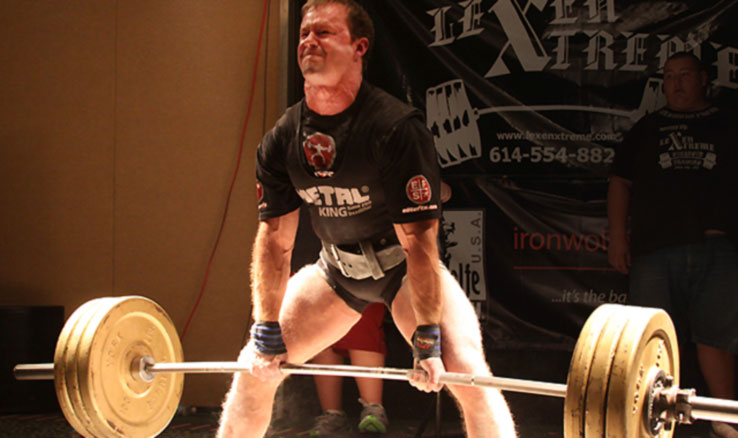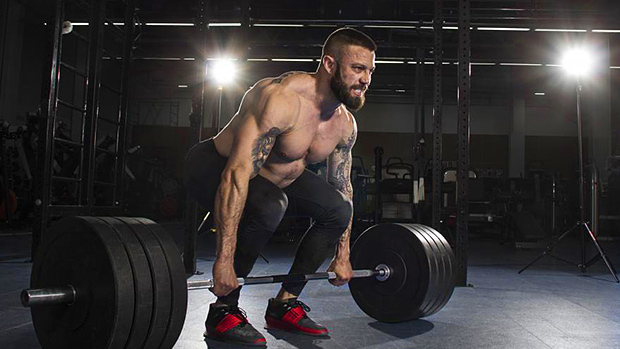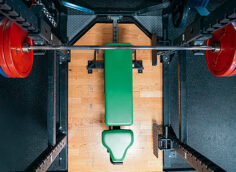Elite Fitness Systems is home to some larger-than-life personalities.
It's not surprising, considering the organization has Dave Tate at CEO and some of the worlds premier strength experts like Jim Wendler and Matt "Kroc" Kroczaleski in the training directory.
But Ted Toalston is shockingly well, normal. The 32-year old powerlifter from Columbus, Ohio is barely 200 pounds, has a mundane 50-hour a week job as a warehouse supervisor, and juggles training with his responsibilities as a new husband and father to two stepsons.
He doesn't even have the street cred afforded by a laundry list of badass injuries – unless you consider suffering a hernia a few years back "badass."
Yet despite being Elite's equivalent to Clark Kent, Toalston hasn't let his everyman personality keep him from putting up some truly badass numbers.
At his most recent meet, he secured a Pro total of 1970 pounds (785/510/675), despite having only started powerlifting competitively in January 2009.
Less than two years to a Pro total? How does that happen?
Toalston's powerlifting journey began in the unlikeliest of places – the dreaded commercial "fitness center."
"I was always kind of skinny and small, so when I started working out 9 years ago I originally wanted to be a bodybuilder," says Toalston. "I had all the magazines and like everyone else, just wanted to get big and muscular like Arnold."
His first few years of "bodybuilding" were hardly productive.

"I trained really haphazardly. I'd do a bunch of bench presses and endless sets of curls, along with a few sets of too-high squats. Oh, and lots of cardio of course."
Despite training like a moron, Toalston was able to get relatively strong, at least by commercial gym standards. "I remember getting up to 405-pound squat, a 450-pound deadlift, and about a 230-pound bench," he says. "Nothing worth writing home about mind you, but it was strong for that place."
Toalston's numbers were enough to draw the attention of powerlifter Mike Ruggiera, who also happened to train there.
"Mike said that I was 'strong for my size.' I honestly wasn't sure what he meant by that, but he was about the strongest guy I'd ever seen. So when Mike offered to let me deadlift with him on Saturdays, I jumped at the chance."
This wasn't the only time Toalston was able to recognize a good opportunity when it was presented to him. After a few Saturdays spent deadlifting, Ruggiera asked if next weekend he'd like to try out a friend's gym in nearby London, Ohio.
That was when Toalston first met Dave Tate.
His first workout at Elite opened him up to a whole new world. "That first lift with Dave we did squats, and I think I missed 405, which is a baby weight in that gym.
"I thought they were going to throw me out, but Dave gave me a bunch of tips instead and even offered to have me back the next weekend."
Toalston started working with Tate regularly and he put up 565/425/600 in his first meet before reaching Elite status shortly thereafter with a 1790-pound total.
Toalston gives full credit to Tate for getting him on the fast track to powerlifting success.
"Dave's tutelage was invaluable," he says. "I'd been training too heavy, with messed up form. Looking back, I knew nothing about programming or technique, both of which are Dave's areas of expertise."
Mastering proper technique in all lifts was Toalston's biggest challenge.
"I'd picked up a lot of bad habits training in the commercial gym," he says. "High squats, butt off the bench during benches, I had my work cut out for me, and at first all of my lifts went down."
"My ego took a beating, at least until I realized that it was my ego that was holding me back."
Toalston says many lifters completely discount how important perfect technique is. "It's as important as your programming, maybe more so. I could hit a 675-pound deadlift today and miss a 500 tomorrow, just by messing up my form."
He also had to learn another important quality: patience.
"People who are relatively new to training always want to push harder and harder – they have no patience. I remember benching 185 one week and telling myself that I should be able to do 190 next week – it's only 5 pounds right? That five pounds is actually a huge jump.
"That's where proper programming comes in. Knowing when to pull back ensures long term progress, and prevents injuries before they start."
Speaking of injuries, Toalston also credits staying relatively injury free for his quick progress.
"I've never been bit by the injury bug – only minor tweaks here and there," he says. "Being a naturally smaller guy, I don't carry around as much weight and that helps. Lets face it, walking around at 200 is a lot easier on the knees than being 300 pounds. That extra weight is going to take its toll."
Tate's balanced approach to programming is also a big help.
"We do lots of upper back and rear delt work to balance all the benching. I do more rowing now than I ever have, and it's made a huge difference."

What's it like training at Elite?
"Elite is just an amazing place. I currently lift there two days a week; it has the best equipment, you can use chalk, and there are strong guys everywhere, pushing you and inspiring you," says Toalston. "The biggest thing is the atmosphere. When you walk in, you just can't help but get overcome by this desire to succeed.
"You just feel like you can't be weak there," he says.
Toalston's next goal is to secure his place on the top 20 All Time list in the 198-pound weight class, a goal he says won't be easy to attain.
"It will take a minimum total of 2,111 pounds to make the list. My bench in particular has got to improve. At my last meet, the guy I came in second to had a 590-pound bench, so I have a long way to go," he says.
"I'll get there. I'm doing my bench work at Elite – so I'm pretty confident. Just in case you're interested, the following is a snapshot of my bench workouts for a few weeks leading up to my last meet."
| Bench Day – October 31, 2010 | |
|---|---|
| Deficit bench with chains (RAW) | 135 plus 2 chains, 3 x 1 185 plus 4 chains, 3 x 1 225 plus 6 chains, 3 x 1 315 plus 6 chains, 3 x 1 315 plus 8 chains, 2 x 1 315 plus 10 chains,1 x 1 |
| Hammer Strength incline press with mini band | 3 x 8 |
| Lat pulldowns | 3 x 12 |
| Cable triceps extensions | 4 x 12 |
| Cable shrugs | 2 x 16 |
| Bench Day - November 4, 2010 | |
| Speed bench | 3 x 6 (205) |
| Close grip dumbbell press (hammer grip), | 3 x 12 |
| Chin Ups | 6 x 10 |
| Dumbbell lateral raises | 5 x 20 |
| Bench Day - November 7, 2010 | |
| Bench Press | 135,3x1 225,3x1 315,2x1 |
| Bench Press w/ Metal Ace (Pro) Bench Shirt | 365x2 (1x3-board, 1x3-board) 425x2 (1x2-board, 1x1-board) 495x1 (1x1-board) 515x1 to chest-PR |
| Raw presses | 365x3 to 2-board 405x3 to 2-board |
| Dumbbell rows | 3 x 12 |
| Cable extensions | 5 x 15 |
| Horizontal press | 3 x 8 (10's) |
| Bench Day - November 11, 2010 | |
| Bench, 185 against mini bands | 6 x 3 |
| Lat pull downs | 5 x 15 |
| Horizontal raises | 3 x 8 (35's) |
| Abs | |
| Bench Day - November 14, 2010 | |
| Incline press | 135, 10x1 185, 10x1 225, 5x1 275, 1x1 225,5x4 205,15x1 |
| Chest supported rows | 6 x 10 |
| Cable Triceps extensions | 6 x 12 |
| Band pull aparts, dumbbell curls, and neck. | |
| Bench Day - November 21, 2010 | |
| Bench | 135, 3x1 225, 3x1 315, 2x1 |
| Bench Press w/ Metal Ace (Pro) Bench Shirt | 365x2 (1x3-board, 1x2-board) 425x2 (1x2-board, 1x1-board) 495x1 to chest 520x1 to chest-PR |
"But to get to my next goals, the two words are rehab and prehab! For 5-6 weeks following the meet, my workouts will all be high volume and higher reps (nothing under 8 reps per set) and no barbell work.
"After that, to improve my bench, I intend on doing more heavy board work to improve my lockout, more shirt work, heavy back work, and working on my technique/form."

Another area he's benefitted from Tate's guidance is nutrition.
"Diet has never been much of an issue for me as I'm a naturally lean guy and I've always eaten pretty clean. But since I've started training with Dave, we've put a lot more emphasis on diet and especially supplementation."
Elite's affiliation with Biotest allowed Toalston to be an official Plazma protocol guinea pig, and he quickly made it a part of his daily routine.
"I take two scoops of Plazma™ and two scoops of Mag-10® every day, even non-workout days. On days off, I'll mix it up and drink it while I make breakfast."
"The biggest thing I've noticed is that I have less soreness after workouts. While I'm normally sore for 4-5 days after a heavy workout, now I'm usually recovered within a day or two. That makes a big difference, especially on the weekends when I train at Elite."
The protocol has also forced Toalston to deal with something he's never faced in the past: making weight.
"One of the few good things about being skinny has always been never having to stress about making my weight class cut-off. This past meet, however, was a different story. I had to come down over ten pounds!
"But considering I still put up a Pro total, I'm not complaining."
Tate also has him taking Metabolic Drive® throughout the day, Mag-10® post workout, and Elitepro™ Minerals before bed, which Toalston says has benefitted his sleep considerably.
"Sleep and recovery are very important, especially as you get closer to a meet or start using a lot of eccentrics or band work, all of which can be rough on the nervous system," he says.
You don't have to pack your bags and move to sunny London, Ohio to make progress in your own training. Toalston says you can make outstanding progress in even the most non-hardcore commercial gym if you incorporate the following tips:
Arrive with your workout planned out.
"Too many guys just wing it, or show up with just the bodyparts they want to train [in mind]. Have a plan before you show up – even if it means writing out your training in the parking lot. The last thing you want to be is that guy who does ten extra sets of something just because there's a hot chick stretching nearby."
Keep a training log.
Planning your workout is step one, but having something written down to refer to is invaluable, especially for percentage-based training. "I don't know of a single strong lifter who doesn't keep a training journal of some kind," says Toalston.
Work hard, but smart.
"Training hard doesn't mean constantly chasing PR's, and there are times when you can just get the required reps in. Progress is still progress, and always trying to hit a new PR will just get you injured."
Plan variety into your training.
"There are dozens of variations of the basic exercises. Try them all. Don't just do barbell rows or T-bar rows. Use different grips and attachments to create a new stimulus and prevent pattern overload."
Don't just do what you're good at.
"Pick a movement that you're a bit weaker at and perfect your form, and then gradually get strong. Often what you suck at or hate doing is exactly what you should be doing."
That's all pretty good advice from a "normal" guy, but we suppose it takes more than just taking off your glasses to become a powerlifting superman.





